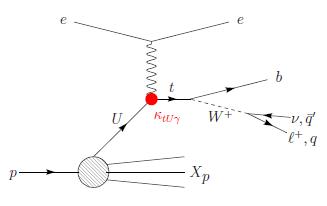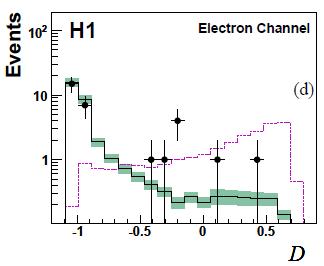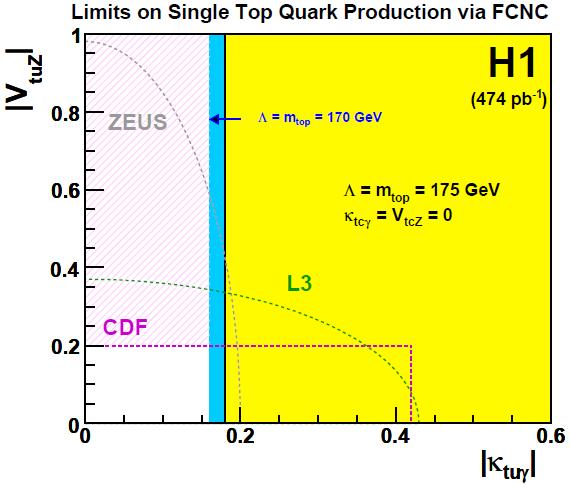Suggestive new results which offer themselves as the first hint of a breakdown of the Standard Model are indeed quite rare nowadays. In a famous post which originated a $1000 bet (taken up in part by Prof. Gordon Watts and in part by Prof. Jacques Distler), no less than 32 months ago I was writing in my old blog:
What do we have to show for these 30 years+ of investigations, smart tests, cunning double ratios, global fits, and the like ? Let me try and summarize - despite I am sure I am going to do a very incomplete job:
- Neutrinos mix and have mass. Ok, that is something. But it does not change by much the physics of electroweak interactions.
- Rb is off, but by less than three sigma.
- the gluon distribution function is larger than it used to be at high x.
- low-energy QCD has made big steps forward, but it also did not change the picture much.
- Radiative corrections imply the existence of the Higgs boson, or something else yielding the proper effect on measurable electroweak parameters. Ok, but the Higgs is part of the SM.
What else ? In Run I, CDF did have a few inconsistencies to keep hope alive, but they died one by one under the blows of merciless re-analysis or more data. HERA had these leptoquark signals, but they died away. Aleph had fancy signals at some point, but it also bubbled down…. One could make this list much longer, but things would not change much.
So, you can well see that during the additional 32 months that passed since September 2006 nothing much has happened in particle physics. That is, if we exclude no-news setbacks such as the continuous delay of the LHC startup. As far as hints of new physics beyond the Standard Model, I can only think at two things:
- the suggestion of a departure from SM expectations of a parameter -the "strong-CP phase"- extracted from Bs mesons at the Tevatron; this is an anomaly staying at about 2-sigma away from the SM;
- the intriguing Anomalous Muon signal unearthed by CDF in a controversial paper: this effect has so far not been confirmed nor (it is my opinion) disproven; it is however quite unlikely (again, my personal opinion) to constitute new physics beyond the Standard Model.
A similar, yet more complete and deeper, list can be found e.g. at the Resonaances blog. In any case, you can well understand that under such shortages, speculative sons-of-a-bitch like me have to cling to whatever sticks its butt above a statistical significance of two standard deviations, or even less. So I cheer up at the new preprint published a few days ago by the H1 collaboration at the HERA facility in Hamburg: they searched for top quark events where none were expected, and found some!
Now, just a moment before I start receiving ugly phone calls, let me qualify that: they do not observe any signal, and thus set upper limits on single top-quark production in electron-proton collisions. However, there is a lot of water between observing a signal and ruling it out. Indeed, what H1 finds is that there is a 2-sigmaish like upper fluctuation which does indeed look like a top signal in their data. A handful of events, to be sure. So let me discuss the result in some detail for you below.
Producing top quarks at HERA
HERA is a quite atypical particle accelerator: it combines some of the strenghts of both electron-positron and proton-antiproton colliders -and a few of the weaknesses- in mixed electron-proton collisions. The collision of 920 GeV protons with 30 GeV electrons (or positrons) produces the release of up to 320 GeV of energy, which can materialize into new states of matter.
320 GeV is less than the total mass of a pair of top quarks, but it definitely is more than the mass of a single one (the most recent Tevatron measurements set that fundamental parameter of the Standard Model at M=173.1+-1.3 GeV). So it is energetically possible that a HERA collision yields a top quark. But are there reactions capable of yielding such events ?
The question is not a vacuous one. The interaction between an electron and a quark within the proton is mediated by electroweak gauge bosons -W or Z particles, or photons- but the Standard Model dictactes that only a W boson can change the flavor of quarks. And since top quarks are not contained in the proton (well, theoretically a proton may be found to contain pairs of those for vanishingly short instants, but it is a really remote possibility), two distinct possibilities are left.
The first: an electron emits a W boson and thus turns into an electron-neutrino; the W boson interacts with a down-type quark (a down, a strange, or a bottom quark) found in the proton, and turns it into a top quark. This process is really rare, and utterly unobservable in the present H1 dataset.
The second: an electron emits a Z or a photon, retaining its identity; the Z boson interacts with a up-type quark (a up, or a charm quark), and magically turns the latter into a top.
Now the most alert of you will be about to object: haven't you just said that only W bosons can change a quark's flavor ? Yes, I did. In fact, the second possibility would be a anomalous process, one which is not possible in the Standard Model until one considers complicated loop diagrams which have ridiculously small probability to occur. So here is a clean process worth searching for: if HERA finds top quarks, they must be due to a so-called "Flavor-changing neutral current" interaction (FCNC), a very striking case of Physics Beyond the Standard Model (BSM)!
 A Feynman diagram of FCNC top quark production is shown on the left. You may notice that the signature includes an outgoing electron, a W boson decay, and a b-quark-originated hadron jet. Those are the bodies one needs to measure to collect top-quark candidates at HERA. Also, the red blob has a specific function: it hides our ignorance of what might produce a change of the flavor in the quark line.
A Feynman diagram of FCNC top quark production is shown on the left. You may notice that the signature includes an outgoing electron, a W boson decay, and a b-quark-originated hadron jet. Those are the bodies one needs to measure to collect top-quark candidates at HERA. Also, the red blob has a specific function: it hides our ignorance of what might produce a change of the flavor in the quark line.There is another thing to note here. The most acute of you might have observed that the W boson in the diagram is positively charged: that is because producing anti-top quarks is much, much harder, because that would imply that the parton interacting with the photon or Z boson is a antiquark. Now, antiquarks do exist in the proton, but it is really difficult to find them with a large fraction of the proton's momentum -which is really called for if the collision is to release an energy of at least 173 GeV.
The H1 Search
 H1 (see right) is endowed with a particle tracker embedded in a uranium-liquid argon calorimeter; both systems are immersed in a 1.16-Tesla solenoidal magnetic field, which allows the measurement of transverse momentum of charged particles. Electrons are well-measured in the calorimeter, and muons can be detected by streamer tubes and drift chambers.
H1 (see right) is endowed with a particle tracker embedded in a uranium-liquid argon calorimeter; both systems are immersed in a 1.16-Tesla solenoidal magnetic field, which allows the measurement of transverse momentum of charged particles. Electrons are well-measured in the calorimeter, and muons can be detected by streamer tubes and drift chambers.The data correspond to an integrated luminosity of 474 inverse picobarns. Luminosity is a measure of collisions since to get the number of collisions producing a given reaction you just have to multiply luminosity by the "cross section" of any given process: cross section is like a probability, but it is measured in units of area: squared centimeters. A square centimeter contains 10^36 picobarns: a billion of billions of billions of billions of them. Oh well: better just say that for a very rare process, one with a cross section of one picobarn, the H1 data should contain about 474 of them.
H1 selects events containing a leptonic W decay -yielding an identified positron or a positive muon- plus missing energy due to the escaping neutrino; a hadronic jet, resulting from the b-quark hadronization, must also be present. The colliding electron which emitted the photon or Z boson is not always detected. After suitable preselection of these objects, 30 events with a positron are found in the data, with a prediction of 31.5+-4.0 from background sources; 8 more with a positive muon are found with a background expectation of 8.0+-0.9. At this level, it seems top quarks are not needed to explain the data -and in fact, the Standard Model does not predict any from the sought FCNC process.
Three reconstructed kinematical quantities are now studied to better discriminate the possible single top signal from the concurring background processes -which have quite different characteristics:
- the transverse momentum of the b-jet candidate;
- the invariant mass of the top quark, reconstructed from the lepton, the neutrino, and the b-jet;
- and an angle describing the W decay properties.
 The three observable quantities above are used to construct a multi-variate discriminant based on a Neural Network. The output of the neural network is shown for electron and muon events in the two graphs on the right (electrons on top, muons on the bottom). Data are shown as black points with error bars, while expected background is shown with a black histogram with blue shaded uncertainty; the pink hatched histogram instead shows the shape of the discriminant expected for FCNC top decays.
The three observable quantities above are used to construct a multi-variate discriminant based on a Neural Network. The output of the neural network is shown for electron and muon events in the two graphs on the right (electrons on top, muons on the bottom). Data are shown as black points with error bars, while expected background is shown with a black histogram with blue shaded uncertainty; the pink hatched histogram instead shows the shape of the discriminant expected for FCNC top decays.Any questions ? As I saw these plots I almost fell off my chair. There is a distinct signal-like excess in both distributions!
 The paper is adamant in explaining that they do see some top-like events, but such signal has an insufficient statistical significance to be interesting:
The paper is adamant in explaining that they do see some top-like events, but such signal has an insufficient statistical significance to be interesting:The top-like events observed in the data at high values of the discriminant lead to observed limits that are weaker than the expected limits. [...] Extracting a production cross section from the discriminant distributions gives for all channels combined sigma(ep -> etX) = 0.11+-0.07 pb. This value is compatible with zero within two standard deviations.Two standard deviations, no more. Rats! But those few outliers in the plots above do look like a nagging signal... If those were the tip of an iceberg just waiting to be digged out, we would be sitting on top of a massive new discovery.
Unfortunately, I must get back to sobriety, and assure you that they are indeed, in all probability, no more than a unfortunate statistical fluctuation. Sure, unfortunate: because of those events, H1 extracts a limit twice higher than it expected on the rare FCNC process. That result is summarized in the graph shown below.

The figure is a bit too technical for the level of this post, but in summary what is plotted is the value of two "anomalous couplings", numbers which parametrize the possibility that the Standard Model needs to be extended with interactions connecting a flavor-changing quark line with a photon (on the horizontal axis) or with a Z boson (on the vertical axis). The name of the game is restricting these two parameters to be as close as possible to zero -zero being the prediction for the Standard Model: no FCNC interactions.
Several experiments have set limits on these couplings: CDF, ZEUS (the experiment competing with H1 at HERA), and even L3 -one of the experiments working at the large electron-positron collider at CERN. The H1 result is an exclusion of the yellow area, which extends down to the blue area if the top quark mass is assumed to be smaller -a lighter top quark would be produced more frequently by HERA, and the constraints are in that case stricter.
In conclusion, H1 does slightly narrow the allowed range of FCNC coupling parameters for single top production. But the experiment also sees a small, nagging top-like signal! Enough to excite all of us HEP perverts.





Comments